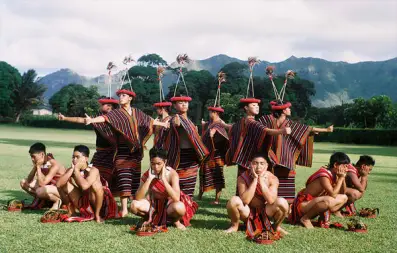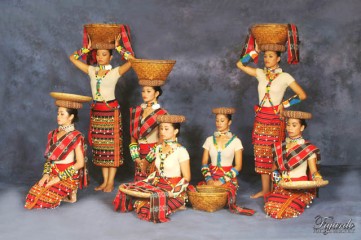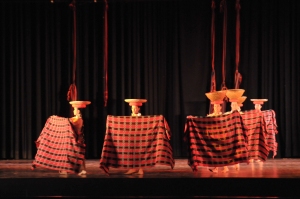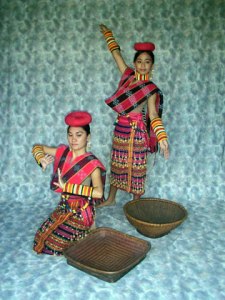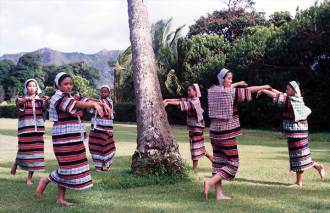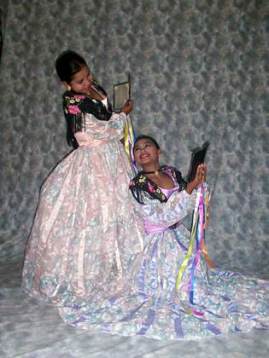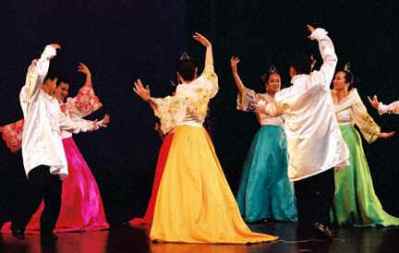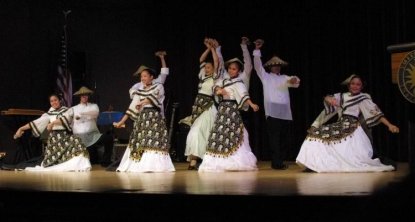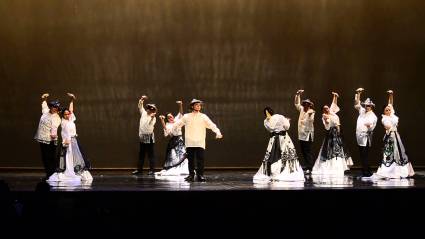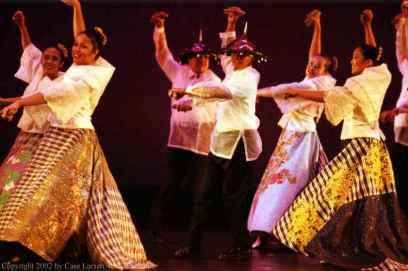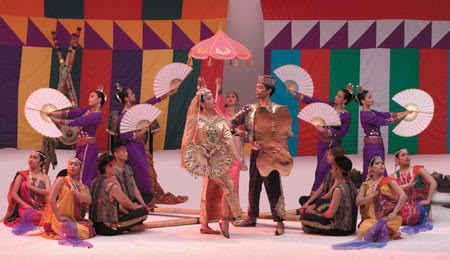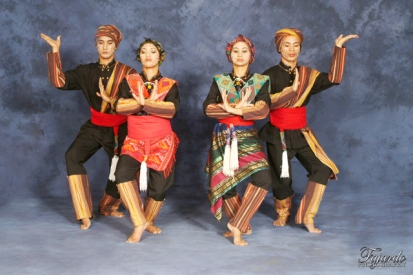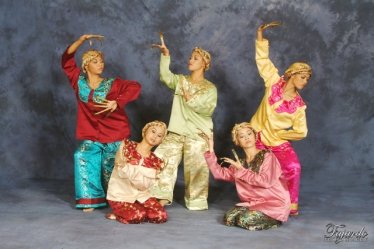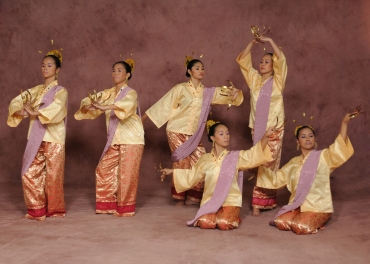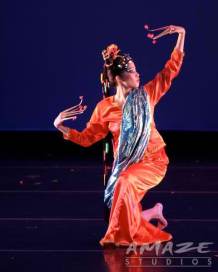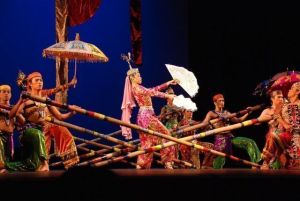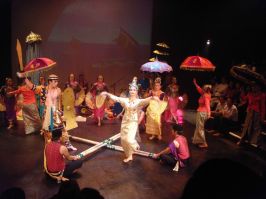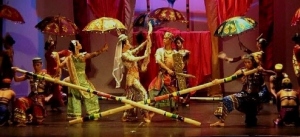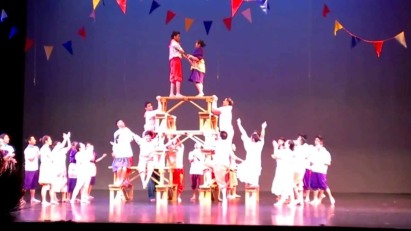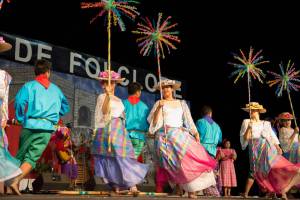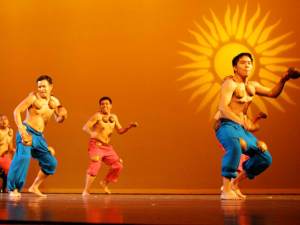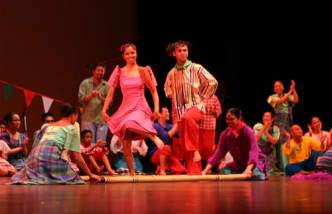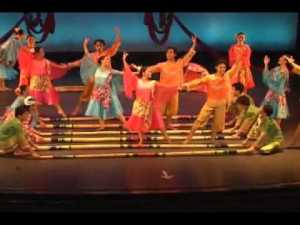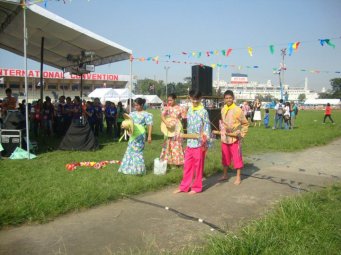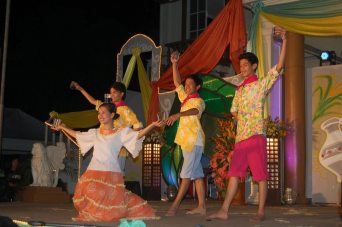The Philippine folk dance from different region gives the culture and tradition meaningful and treasured memories from early time up to now. So, that it is important for us to know, memorized some of it to show our patriotism in our mother land. The dances for north is called Cordillera, s Maria Clara dance that evolve from Spanish Colonization, Muslim dance from the South of the region and Rural dance from different provinces in Visayan region that mostly a dance of happiness and celebration.
CORDILLERA SUITE
UYA-OY
(Magayao, Ifugao) The rice terraces of Banue are home to hundres of small and large feasts called canao. Each canao has a different purpose: weddings, hope for good harvest, success in war, or the death of prominent villagers. The grandest of all canao is the uyaoy. The uyaoy is mainly celebrated by a Kadangayan or chieftain of the village In order to reaffirm his social status In the community. Men spread their arms to imitate the sakpaya hawk’s majestic glide and stamp their feet to affirm their affinity with the cosmic earth as the women throw their arms upward while scratching the ground with their toes.
Video- https://www.youtube.com/watch?v=kuT6xocbGVw
RAGRAGSAKAN
(Cordillera) portrays the Kalinga tribal women as they balance baskets on top of their head and walk carefully along the mountainous rice terraces to not wander off the path through the fog. Their bright and colorful, handwoven fabrics help to keep them warm.
Video: https://www.youtube.com/watch?v=Brdi1nBHHDU
BENDIAN
(Banguet) Bendian is performed for many reasons. Some of which are to heal a prolong illness; relive natural calamities such as famine and drought, and to celebrate a bountiful harvest. However, the biggest Bendian is to celebrate a victory in a war and a successful headhunt. The arrival if a successful head taker, called “ului” is met with great festivities by the entire village. The Bendian festival celebrated by the Banquet, Ibaloy and Kankanay is always big extraordinary. It involves the village circling and dancing around the ulul leader while executing various arm movement. Lasting until the wee hours of the night, the bendian ritual ends on the sound of the loudest oway or war cry. This version of Bendian centers around the maiden’s part of the circle.
V: https://www.youtube.com/watch?v=CeL8zNtX4Zo
MA. CLARA SUITE
LA ESTUDIANTINA
is a Spanish-inspired dance of the Philippines. The country was under the rule of Spain for more than three hundred years, during which time local culture was markedly influenced. Young women who studied (at home with tutors for instance) used to be calledestudiantina (male students were called estudiante), and this dance was originally performed by women carrying a book or a fan, items associated with female students. There are many regional versions of this dance. The one in the video below is from Samar. There is also another popular version from Quezon province. Philippine dances derived from Spanish influences, such as the La Estudiantina, are classified as Sayawing Maria Clara (Maria Clara Dances). Maria Clara is the main female character in the Spanish-era novel Noli MeTangere, written by Filipino national hero Jose Rizal. Maria Clara also refers to a women’s style of clothing popular during Spanish times, which is worn as traditional Filipino costume even today. Filipina performers of dances like the La Estudiantina wear Maria Clara-style dresses.
V: https://www.youtube.com/watch?v=EQzRmegUWr4
ABARURAY
the Abaruray de Catanauan from Catanauan, Quezon Province. The version is popular among Southern Tagalog festivities like baptisms, town or barrio fiestas and similar festive occassions. The dance is unique with a remarkable flexed-elbow-flap called binanog believed to have been introduced by the Bicolanos.
The original Abaruray dance is supposed to have originated in Marinduque where many versions of the Abaruray are found. One very beautiful version of this dance is the Baruray from Barrio Matuyatuya, Torrijos, Marinduque. There is also a version found in Samar where it is called Abalulay, the Samar Abaruray is included in the “Curacha Samareña”.
V: https://www.youtube.com/watch?v=-hDkM2SbzPQ
Jota Manileña
is a version of the Spanish jota which originated in Manila. Bamboo castanets are made useof in this dance.
La Jota Manileña
It is a dance named after the capital city of the Philippines, Manila,where an adaptation of Castilian Jota afloats with the clacking of bamboo castanets playedby the dancers themselves. The costume and the graceful movements of the performersnoticeably inspired by Spanish Culture.
Jota
is a genre of music and the associated dance known throughoutSpain, most likely originatingin Aragon. It varies by region, having a characteristic formin Valencia,Aragon, Castile,Navarra,Cantabria,Asturias,GaliciaandMurcia. Being a visualrepresentation, the jota is danced and sung accompanied bycastanets,and the interpreters tend towear regional costumes. In Valencia, the jota was once danced duringintermentceremonies.The jota tends to have a 3/4 rhythm, although some authors maintain that the 6/8 is better adapted tothe poetic and choreographic structure. For their interpretation,guitars, bandurrias, lutes, dulzaina,anddrumsare used in the Castilian style, while theGaliciansusebagpipes, drums, andbombos. Theatrical versions are sung and danced with regional costumes and castanets, though such things arenot used when dancing the jota in less formal settings. The content of the songs is quite diverse,frompatriotismtoreligionto sexual exploits. In addition to this, the songs also have the effect of helpingto generate a sense of local identity and cohesion.The steps have an appearance not unlike that of thewaltz, though in the case of the jota, there is muchmore variation. Furthermore, the lyrics tend to be written in eight-syllablequartets, withassonanceinthe first and third verses.Some non-Spanish musicians have made use of the jota in various works:
La jota
The Philippine Jota was among the most popular dances during the Spanish colonial period in thePhilippine. It was originally performed by the SpanishSeñoritasandCaballerosin social gatherings(like wedding, parties and baptismal) during the Spanish regime in thePhilippines.The Filipinosimitated and adapted this lively and delightful dance with different versions. These versions arecombinations of Spanish and Filipino dance steps and music. Notable differences between thePhilippine and Spanish jotas are the use of unstrung bamboocastanets. The jota is accompanied bythe Philippine rondalla often consisting of a bandurria, guitar, bass and other mandolin-typeinstruments.Variations of jotas differ from region to region. One such example is the Jota Paragua. The JotaParagua came from Palawan’s old capital-Cuyo Islands displays a heavy Castilian influence.Thezapateados(footwork), cubrados (curved arms), andSevillana (flounced and ruffled) style of dressare evidently Spanish in origin. The ladies wave their mantón, or decorative shawl, while the gentlemenkeep brisk pace with bamboo castanets. The music is an alternating fast and slow tempo similar toSpanish airs which accompany dances like the flamenco, jota,bolero,seguidillaandfandango.Other examples of Philippine jotas are Jota Manileña from Manila, Jota Caviteña from Cavite and JotaMoncadeña from Tarlac
V: https://www.youtube.com/watch?v=HPuVaSHmAcw
MUSLIM SUITE
PANGALAY
The Pangalay Dance Style of the Philippines: An Intangible Cultural Heritage
A Paper by Ms. Ligaya Fernando-Amilbangsa, Intangible Cultural Heritage Practitioner
Artistic Director, Alun-Alun Dance Circle
Pangalay: literally, a gift offering.
Pangalay also means “temple of dance” in Sanskrit. Pangalay antedates Christianity and Islam in the Philippines. Among Philippine indigenous dances, the pangalay dance style has the richest movement vocabulary. It is the closest to a classical form.
Pangalay is a living link to the traditional dance cultures of Asia with closest affinity to the Indian, Javanese, Thai, Burmese and Cambodian styles of classical dancing.
A living artifact such as the pangalay must be danced constantly, or else it dies. The beauty of the pangalay dance style is that it can be danced to any type of music, Asian as well as Western. The pangalay can be danced by anyone and everyone in the community, regardless of age or status. It can be danced in any space, be it on a boat, on a house-porch or on the beach.
Pangalay is basically pure dancing. A sense of anti-linear time pervades the slow, refined, meditative, elegant and almost hypnotic movements. The continuously flowing or seamless unfolding movement from a central core is consistent with the pre-modern mode and Eastern sense of multi-level or anti-linear time that has no definite beginning or ending. This is opposed to the Western concept of time or the metempsychosic scale.
The dancer’s serious face with downcast eyes creates a mask-like expression, matched by a countenance generally refined, dignified but without stiffness.
The dancer’s torso is slightly bent forward, a stance seen in Asian dance forms, Unnecessary hip and torso movement is tabbo. The knees are slightly bent or flexed. Male dancers also splay the knees. Performers achieve the illusion of lightness by the very subtle springing motion from the knees.
Feeling is conveyed chiefly through the arms and hands. Fingers are customarily held stiffly together and curled back towards the dancer’s wrists with controlled energy, thumbs apart and thrust forward. Fingers may flick, flip or flutter. The janggay or metal claws amplify eloquent hand movements.
Shifting arm positions to assume new postures or gestures is accomplished by turning the hands from the wrists with one outward-inward movement, two outward-inward motions or inward-inward motions.
Postures and gestures suggest emotional metaphors and symbols that offer a broad range of expression. For instance: outstretched palms and arms can stand for salutation, welcome or joy; or, as a symbol of things in nature such as a palm leaf, flowers, sea waves, the wind, sea weeds, a bird and a flutter of wings.
Crossed arms and hands at chest or face level signal a protective or playful impulse. Overhead hand positions display triumph, extreme happiness, jubilation or sudden increase in status.
Sculpture-like poses, cross-legged and kneeling stances, coupled with flowing gestures with the arms extended farthest away from the body convey a sense of infinite distance and timelessness.
“Motion in stillness, stillness in motion. This is the Pangalay.
V: https://www.youtube.com/watch?v=sdS2MCQ37Fw
JANGGAY
Janggay is a set of brass or silver fingernails (left photo) worn by Bajao (Badjaw) women when dancing to enhance their already bent fingers. There are short unadorned janggay nails and there are longer ones that are flower tipped. (The fingernails also mimic the claws of the birds and is considered one of the “bird” dances.)* This dance has taken its name from the janggay fingernails and could be performed by a couple of women, 4 or more. Boat weddings, Muslim festivals and Ramadan become the reason to celebrate and perform janggay dance.
Costume: Loose topper called biyatawis made of silk or metallic brocade cut in the style of the Japanese happy coat; loose pants called sawal of the same material; shoulder band usually in malong form (tubular skirt) of the same material but of contrasting color and design
Accessories: 10 janggay nails; a pair of earrings
Head decor: veil called putong of a meter square made of silk or flimsy material attached to the back of the head or a bun (pusod). Some headdresses are shown on the lower left photo. Some have used colored pipe cleaners and visors for the headdresses.
V: https://www.youtube.com/watch?v=cS2Rqw0K_-c
SINGKIL
Chimes and bronze gongs herald the entrance of the Muslim princess, resplendent in dazzling golds, sapphire and other jewel tones. Her entourage of ladies-in-waiting precede her with scarves, fans and decorative umbrellas, flourishing their measured movements. The princess’s manservants carry her in a litter or sedan chair (depending on the capability and resources of the dance company) in a solemn procession. Upon her ankles the small bells mark her movements.
A suitor courting the Princess dances opposite her bearing a kris and shield, the pace of the bamboo poles between which closures they skillfully navigate quickens pace. Her main lady attendant – some scholars list her role as‘slave’ – dutifully follows her mistress.
The musicians on the kulintang, or brass gong, match tempo of the bamboo clappers. The kulintang musical ensemble is related to the brass gong instrumentation of Indonesia called gamelan. These instruments are forged and tuned to each other, they cannot be separated or mixed with other ensembles.
But, all the sources – including this wiki agree – that, yes, the Singkil IS a traditional Muslim dance, as it is a dance of the Maranao, a Malay Muslim or Moro people or tribe. But the dance’s roots go further. To India, in fact! TheSingkil Wikipedia page notes:
The Singkíl originated from the Maranao people who inhabit the shores of Lake Lanao. It is derived from a story in the Darangen, the Maranao interpretation of the ancient Indian epic, the Ramayana [indicating the dance’s Hindu spiritual origin]. The name of the dance itself means “to entangle the feet with disturbing objects such as vines or anything in your path”. It is a popular dance performed during celebrations and other festive entertainment. Originally only women, particularly royalty, danced the Singkíl, which serves as either a conscious or unconscious advertisement to potential suitors.
The lead dancer, in the role of Putri Gandingan (the Darangen name for Sita), graciously step in and out of closing bamboos poles arranged in either a parallel, rectangular, or criss-cross fashion while manipulating either apir (fans), mosala (scarves), or even just their bare hands. A kulintang and agung ensemble always accompanies the dance.
After the ancient origins, the next reference I found online about thesingkil was in the 1950s. The dance became a popularized Philippine folk dance by the help of historians-dancers-ethnomusicologists, Bayanihan Dance Company. In particular this dance was researched, interpreted and staged by the Bayanihan’s Lucrecia Reyes-Urtula, who went on to be named a National Artist of the Philippines for her contributions to cultural heritage in dance. The Company performed Filipino folk dances for audiences around the world, even for Ed Sullivan, to much acclaim.
Additionally the authors of the Singkil Wiki level judgement on the Philippine national dance company, Bayanihan:
When the Bayanihan Dance Company began performing the Singkíl, the traditional dance was adapted to convey Western aesthetics. The Bayanihan portrayal, branded as the Princess Dance or the Royal Maranao Fan Dance, became so popular that it is often mistaken for the authentic version of the dance.
I, too, was guilty of this same crime, believing in the authenticity of the Bayanihan singkil interpretation now replicated by innumerable dance companies and Filipino student groups around the world. Although — the Bayanihan in their mission statement make no secret of the fact that the historical folk dances they present are reinterpreted and restaged for ‘contemporary’ audiences:
…to research on and preserve indigenous Philippine art forms in music, dance, costumes and folklore; to restructure and enhance these research findings to evolve repertoires suited to the demands of contemporary theater; and to promote international goodwill through performances at home and abroad.
V: https://www.youtube.com/watch?v=kkMhBhfBuHU
RURAL SUITE
KARATONG
Kalatong or Karatong have dancers use kalatong or bamboo tube about a yard long, tied horizontally below the waist and struck by two sticks to tap the rhythm of the dance. there are two dances – The Tobong Kalatong, from Pangasinan, which is a ceremonial dance performed to frighten the evil spirits away.
Bunga Mangga, from Cuyo, Palawan, is a part of the Karatong in which dancers collect flowers from the mango tree – thus the bunga mangga contraption.
(Cuyo, Palawan) The annual parade of San Agustine includes the celebration of blossoming mango trees that grow abundantly on the island of Cuyo, the former capital of the Palawan province. Starting at the church patio and ending at the town plaza, groups of ladies sway their colorful “bunga manga,” which are meant to represent the flowers of the mango tree while the men strike lively, syncopated beats with their karatong.
V: https://www.youtube.com/watch?v=b4-N7MR0le8
MAGLALATIK
TheMaglalatik is an indigenous dance from the Philippines in which coconut shells halves that are secured onto the dancer’s hand on vests upon which are hung four or six more coconut shell halves. The dancers- all male- performed the dance by hitting one coconut shell with the other. Sometimes the ones on the hands, sometimes the one on the body, and sometimes the shells worn by another performer, all in time to a fast drumbeat.
Originally performed in Binan Laguna as a mock- war dance that demonstrates a fight between the Moros and the Christians over the prized of a latik or coconut meat during the Spanish rule, this dance is also shown to pay tribute to the town’s patron saint, San Isidro Labrador. It has a four- part performance such as the palipasan and baligtaran showing the intense battle, the paseo and the escaramusa- the reconciliation. The Moro dancers wear red trousers while the Christian dancers show up in blue. All dancers are male with harnesses of coconut shells attached on their chests, backs, thighs and hips.
V: https://www.youtube.com/watch?v=do4GyUk3XKc
TINIKLING
Tinikling involves two people hitting bamboo poles on the ground and against each other in coordination with one or more dancers who step over and in between the poles in a dance. It originated in Leyte among the Visayan islands in central Philippines as an imitation of thetikling bird.
Once taught simply as a folk dance from the Philippines, it has recently become popular in the sports curricula of elementary schools as it involves skills similar to jumping rope. It’s now a new, fun form of aerobic exercise that also improves spatial awareness, rhythm, foot and leg speed, agility, and coordination.
V: https://www.youtube.com/watch?v=oCUEeSIVCxU
————————————————————————————————————
References:
http://www.hiyas.org/igorot.html
http://www.likha.org/1992/09/kalatong-or-karatong.html
http://www.ecddancecompany.com/portfolio-view/ragragsakan-cordillera/
http://aboutphilippines.ph/Video-descriptions/La-Estudiantina-Filipino-Dance.pdf
http://en.wikipilipinas.org/index.php/Abaruray
http://pangalaydance.com/the-pangalay-dance-style-of-the-philippines-an-intangible-cultural-heritage
http://kidstale-nm.com/kidstale-nm.com/Janggay.html’
http://philippinecultures-talents.blogspot.com/2012/01/maglalatik-dance.html
http://tagaloglang.com/Filipino-Culture/Philippine-Dances/tinikling-bamboo-dance.html
———————————————————————————————————
John Patrick Manzano
Ctp
Edtech5
Project


